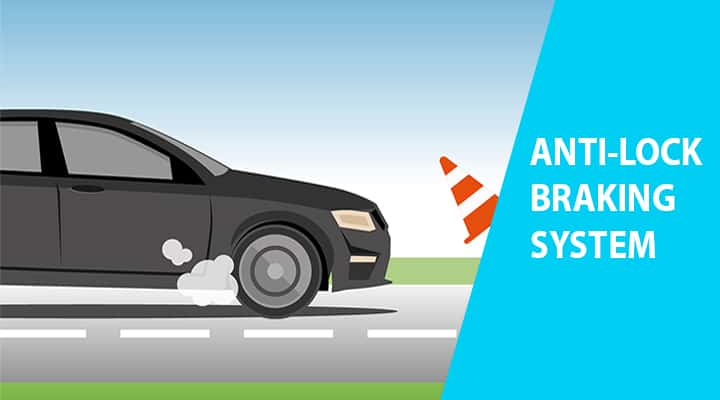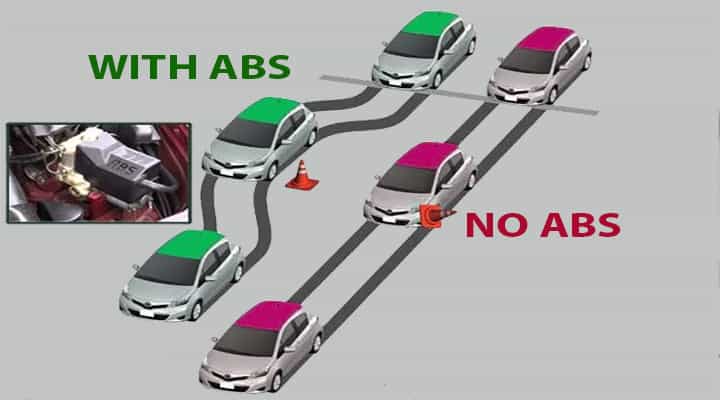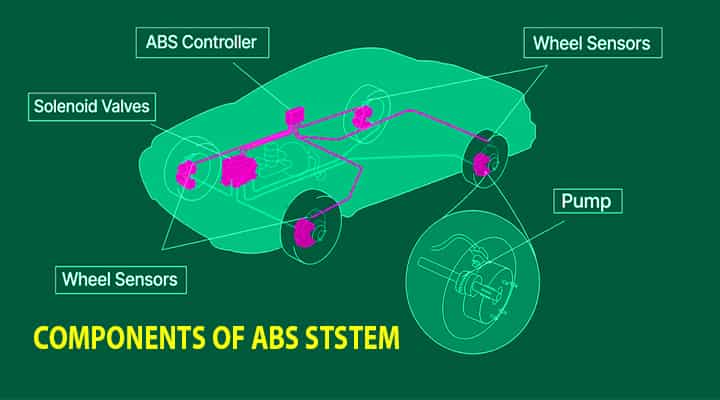What is ABS or anti-lock braking system in car explained along with very basic details, types, different parts, working principles, advantages, disadvantages etc. Let’s explore the Anti-Lock braking system!
ABS or Anti-Lock Braking System in Car
Do you have any idea about ABS in Car or Anti-Lock Braking System! Nowadays, in automobiles the most important factor that is getting considered is vehicle safety. Lots of manufacturers are employing safety methods and ways for their products.
One of the widely used and employed system for brakes is the Antilock braking system. If you want to know about What is ABS and why is it important to have nowadays, follow this post. ABS is not only used in cars but also in Aircrafts, trucks, buses etc.

The safety of vehicles is the most highlighted as well as selling point of vehicles nowadays. ABS used multiple sensors and combination of electronics and mechanical parts.
- The introduction of ABS into automobiles made a new look to towards the safety.
- There are numerous advantages of ABS system.
- The modern cars now have the improved ABS with lots of enhancements like automatic steering control and traction control.
What is ABS or Anti-Lock Braking System?
The ABS or Anti Lock Braking system is anti-lock braking system that prevents the wheel from locking up and maintain the grip. Suppose, you are driving a car and to avoid a sudden collision, you need to activate the brake suddenly. This might skid your car and cause fatal accidents. So basically, to avoid skidding the ABS or anti-lock braking system is employed.

If we go back in history, the anti-skid system used in the 1950s in an aircraft.
Later Ford and Chrylser employed the system in cars. It helps in steering the vehicle on stop as well as with the traction control.
Now the ABS is used in almost every modern car as well as in high-end bikes.
The use of Electronic control unit (ECU) made ABS even better with more accurate controls. ABS is also known as traction control system, emergency brake assist, electronic stability control.
Components Of ABS
ABS in car is part of an automatic braking system. It is a combination of Electronics and Mechanical parts.
The ABS has 4 major components,
- A speed sensor,
- Valves,
- Pump, and
- Controller.
Let’s know more about them one by one.
Speed Sensors
As we already know ABS prevents the locking wheels to retain and maintain traction. So the ABS needs to know the wheel is going to get locked or not. To determine this the speed on the wheel should be known. A speed sensor basically is having a toothed ring and magnet within a coil.
- The contact of ring and magnet causes the magnet to induce an electric field that results in generating a sign.
- The ABS controller receives only a digital signal so the signal is converted to a digital signal and then transferred to the ABS controller.
- The controller will get the speed of each wheel.
- They are located on each wheel to measure the speed of each wheel separately.
- These speed sensors are major keys to control the skid and stable working of ABS.
Valves
The valves in ABS acts as a brake force controlling factor. It has a role of controlling pressure according to the conditions. A separate valve is provided on each brake to be controlled the ABS. Sometimes when the break is pushed harder it will limit the pressure as well as when the force is not enough it will apply more pressure for smooth working.

The valve different positions for different conditions. Basically, the valve has 3 positions, these are explained as below.
Position one
This is the open position, the pressure from the master cylinder is passed to the break. The pressure will be directly allowed to flow through cylinder to brake.
Position two
This is known as block position, When the driver pushes the brake too hard the valve blocks the line of pressure from master cylinder. This action will stop the extra pressure rise and maintain stable pressure for breaks.
Position three
This is the release position. As the name suggests, it releases the pressure applied on the brakes. There is one problem with the operation of valves. If the Valves get clogged or it is unable or open and close it will become inoperable. The pressure will not get controlled until and unless the valves does not get clogged.
Pump
The pump stores the hydraulic fluid. When the valve requires or releases the pressure the fluid needs to go back or stored. The pump carries out this work, it will store the fluid when the pressure is released.
- The pump acts like storage for fluid, it supplies and takes back the fluid whenever required.
- The controller controls the pump and the amount of fluid that pump would suck or transfer to and from valves.
- The fluid used is the hydraulic fluid and it travels from hydraulic lines to breaking mechanisms.
- When brakes are operated, they produce lots of heat, hence the fluid used should have a high boiling point.
Controller
The ABS controller is the electronic control unit (ECU). Its like a brain of human which controls all the actions based on the feedbacks of body parts.
- The controller is the one who receives all information from speed sensors.
- Speed sensors send digitized signals to the controller.
- When one of the wheels loses traction, the signals are sent to the controller.
- Now after receiving the signals ECU actuates its mechanism and controls the braking force.
- It will actuate the braking valve actions.
Working of ABS in Car
We already know the speed sensors are placed on each wheel separately.
- The wheel sensors send the signals to ECU.
- The speed sensors are used to detect the locking wheels when the wheel is about to stop or is skidding.
- When the wheels are locked up it will experience sudden deacceleration.
- To stop the sudden deacceleration, it needs to pump up the brakes slowly.
The valves operate at about 15 times per second. Due to which the driver can experience pulsing in the brake pedal. The ABS controller reduces the pressure to brake until the acceleration is experienced and it will increase the pressure until it experiences the accelerations again.
That’s the reason valves operate about 15 times a second to keep in check of these cycles. The ABS system will keep the wheels near the locking point. It will not allow the wheels to lock up at the same time giving the maximum braking power.
Types of ABS Brakes
The ABS brakes have 5 types. They can be differentiated on the basis of numbers of sensors, channels and controlling valves.
Four Channels four-sensor ABS arrangement
This is one of the best arrangements available.
- The speed sensor is provided on all of the 4 wheels of the vehicle.
- The controller will monitor each wheel individually with the feedbacks from the speed sensors.
- This arrangement gets full control of the vehicle braking system.
Three channels, four-sensor ABS arrangement
This arrangement has the speed sensors deployed on each of the wheel. Also, separate valves for each of the front wheel just like the four channel four sensor system.
- The main difference is the for the rear wheels only one valve is provided.
- This arrangement was mostly used in older vehicles.
Three channels, three-sensor ABS arrangement
This arrangement has the sensors and valves for each of the front wheels. But the difference lies in the rear system of the vehicle. Only one valve and one sensor is provided for both rear wheels.
- This system is mostly used in pickup trucks.
- The front ABS will be activated even when one of the wheels starts to lock. But for the rear, even one wheel gets locked the ABS will not be activated.
- Both the wheel is needed to get locked to activate ABS on the rear wheels.
Two-channel, four-sensor ABS arrangements
This arrangement has the separate speed sensor for each wheel. It will monitor the speed from all of the wheel. But the valves are provided one for a rear and one for front.
- The valve is arranged in a pair.
- This was commonly used in older vehicles.
One Channel, one sensor ABS arrangements
As the name suggests, only one valve and one sensor are used in this system. The vehicles that have ABS on the rear side only employ this arrangement.
- This one has the same working mechanism as the three-channel three-sensor system.
- Both the wheels at the rear need to lock before activating the ABS system.
- It can be possible that one of the rear wheels gets locked up but still, ABS can’t be activated result in reduced brake effectiveness.
- These are all types of ABS arrangements used in different vehicles.
So what are the benefits of the Anti Lock Braking system? let’s check them out now.
Benefits Of ABS
There are so many benefits of Anti-Lock Braking system in car,
- The most important benefit is the skidding of the vehicle and locking of the wheel is avoided. You might already know how fatal accidents can get if the car gets skid or wheels get locked.
- ABS is a lifesaving safety feature that is a must-have feature in all of the bikes and cars.
- Controls the vehicle in heavy braking situations.
- Vehicles equipped with the ABS experience shorter stopping distance compared to without ABS vehicles.
- Protects tires from excessive wear.
- Restores the grips and traction of wheels by slightly applying the brakes.
- The process is automated, there is less chance of inaccuracy.
Although there are numerous advantages of the ABS system regards to reduced risk of accidents. But there are chances of increased run-off road crashes. The results of ABS changes on the surfaces like snow and gravel. The limitations of ABS are experienced on some surfaces.
In case ABS fails on these conditions, the driver must apply the manual brakes. There are some disadvantages let’s check them out now.
Limitations Of ABS in car
There are a few limitations also in Anti-Lock Braking system,
- The main primary disadvantage is related to cost. Because Anti Lock Braking system adds some extra cost to the maintenance as well as the overall cost of the vehicle.
- Maintenance costs of sensors, if they are out of calibration
 , is a bit heavy.
, is a bit heavy. - Surely the ABS help in braking, but there’s a side effect of inconsistent stopping distances.
- Regular check-ups of sensors, brake fluid, and valves are a must.
- The electronic systems are delicate, it can be harmed easily and the repair cost is heavy.
- ABS doesn’t compensate for unsafe driving and poor road conditions.
Also, there is misconception that ABS will help in reducing the stopping distance. If you drive directly to obstacle car may not stop in time. There are more advancements made in the ABS. Like, automatic traction control. This system applies the brakes when drive wheel spins and lose traction. It is useful when one of the wheels is on good surface and another wheel is skidding.
- The stability is important factor considering the vehicle safety. Automatic stability advancements in ABS makes ABS even safer. This advancement is also known as electronic stability programme.
- The control system will apply the brakes momentarily at any one wheel and it will correct the oversteer or understeer.
- There are other sensors used in this case like a steering angle sensor which sends the angle measured signals to the controller to take further actions.
We have seen its advantages and limitations but its really effective? And what changes you can experience if you don’t have ABS in your car, let’s know them each.
The ABS, how effective it is?
The Insurance Institute for Highway Safety (IIHS) has conducted various studies to study the effectiveness of ABS. They found out an average of 27.2% stopping distance was increased on loose gravel.
The study conducted in 1996 showed vehicles equipped with ABS overall no less likely to get involved in fatal accidents. But they also stated, the threat to other cars would be minimal but the threat of accident damage to the own occupants of the car is more.
The aggressive steering is any day going to be disastrous for the driver. In addition with aggressive steering ABS can act as addition to more fatal accident like car rollover or collisions. The experience with the ABS is best on solid surfaces but it changes with the snowy field or gravel.
There are some numbers drawn out about 35% decrease in frontal collisions and 9% decrease in frontal impacts. Also, there some speculations about the driver’s skill and how he uses the ABS system. But with the advancements discussed above the ABS is getting improved. So what happens if you car don’t have ABS? Let’s find out.
What if my car doesn’t have ABS?
If you not driven the ABS car you don’t really notice the difference. Its obvious that with ABS you are getting extra layer of security. But if you are not making emergency stops you will not find any difference either. But if you are making emergency stops or drive the car where you need braking continuously the ABS is saviour.
The ABS support your vehicle by not locking the vehicle when you stomp on the brakes which is excellent in the cases of emergency stops.
If your car doesn’t have Anti-Lock Braking system you should take care of few things. Like before turning you’ll have to slow down your vehicle at the most possible speed because there is no presence of ABS to adjust and support your steering.
If you are driving take-off your foot from the accelerator pedal and push the clutch down. Also, you need to push the brakes as much as you can until you feel like the wheels are locked and take your foot off from the brakes. You can reapply the brakes again, this exactly replicates the working of ABS.
The ABS system has proved itself as a safety equipment which is a must have for any modern vehicle. All the vehicles with conventional braking system are 40% prone to accidents by skidding and locking of the wheels.
In the upcoming time, advancements are expected in ABS to make it even more reliable in adverse conditions. The driver must read the car manual for getting the idea of ABS used in the car.
Conclusion
So, we have learned the basics of the Anti-Lock Braking System or ABS system, its components, applications, advantages etc. If you have any queries, please write to us.
